

|
Home Updates Hydros Cars Engines Contacts Links Contact On The Wire |
Jimmy Jones and 'Wee Gareth'.
|
|
‘Wee Gareth’ is a very typical example of British ‘C’ class 10cc tethered hydroplanes from the 1960s, before aerodynamics, streamlining and tuned pipes became the norm. There are no concessions to beauty however, it is long, narrow, and simply constructed, with a view to producing maximum performance from the home built 10cc racing engine. ‘Gareth’ was built in the mid 1960s by one of the icons of the tethered hydroplane world, Jimmy Jones. |
|
Jimmy, like so many other hydroplane enthusiasts, was a toolmaker and worked for BICC in Liverpool from around 1955. He started his involvement with tethered boats in 1937 with the first of the ‘Miss Fyre’ series, a 9cc two-stroke engine in a kipper box hull. In 1946 he wrote an article in the Model Engineer featuring ‘Miss Fyre II’ that had gained him first prize at a civil defence exhibition in Liverpool. The hull was the 24" ME design published in 1939 with a Kittiwake engine that he built himself in the early years of the war. He thanked Edgar Westbury and the Model Engineer "For setting him on the way". Jimmy was a prolific builder with at least 4 ‘Miss Fyre’ hulls and engines, no less than 10 hulls in the Mambo series, Sea Jay with its engine built as a joint project with Tom Clements and others as well. Jimmy with his ‘trademark’ beret and his wife Ethel competed across the country from 1946, right through to the 80s, racing their stable of 10 and 15cc boats. |
|
|
|
As well as building his own boats and engines, Jimmy was responsible for encouraging and helping numerous other competitors, including Tom Clement who was to become a life-long friend. He provided ‘enthusiastic guidance’ for the current A/S record holder Bob Kirtley to develop his highly successful flash steam hydros. Two of his colleagues at work, Frank Burns and apprentice Don Mason, also built boats under his guidance. Jimmy lived in Maghull just to the north of Liverpool and was founder member of the Maghull Model Engineering society in the late 30s as well as forming the Maghull Boys Club in 1945. He was also prominent in the Crosby Model Boat club that raced at Crosby lakes just a stones throw from his house. When the Maghull MES folded around 1950 he moved to the Birkenhead Club acquiring the registration BD3. |
|
The bright red ‘Wee Gareth’ first appeared in 1966 with Jimmy fulfilling a promise to name it after his grandson. During its competitive career two very different engines were installed and it is seen here with one of a pair of home built engines, with distinctive square fins on the cylinder and cylinder head. These motors had originally been built in the 50s and one had powered an early ‘Mambo’, while his wife, Ethel, had used the other identical motor in her own 10cc boat. |
|
|
|
From Jimmy's own regatta book comes this record of 'Gareth' winning the 'C' class event at the Birkenhead Open Regatta in April 1969. This run of 56.51mph also gave Jimmy the Club Championship. We are indebted to Alec Graham for the loan of Jimmy's Regatta Book. |
The second 10cc motor was built from the same castings as the engine in Dick Phillips ‘Foz II’, one of the most consistently successful home built 10cc motors and one of only two home built 10cc motors ever to hold the outright British record. Similar in style to a Dooling 61, Jimmy’s version of the motor produced initial runs in the mid 50s. Gradually the speed crept up in to the 60s, but Gareth was unable to compete directly with the McCoy and Dooling motors that were tending to dominate the class. By 1972 this engine had been removed for use in another boat.
|
|
|
|
| Motor built from 'Philips' castings. | Components of 'Dooling' style motor. | Square fin engine in 'Scorpio'. |
The ‘new boat’ never materialised and so the ‘best’ Dooling style motor went back into Gareth for a while, before the boat was put into semi retirement around 1975. One of Jimmy's original square fin 10cc motors is in the late Bob Hymer’s 'Scorpio', which is now back in the care of his home club following the closure of the Pitsea museum.
|
In 1976 Gareth was loaned to the Heaton Model Boat Club where George Wade and his son Malcolm ran it for 3 seasons. Sadly, in 1979 at Birkenhead, the motor gave up the unequal struggle. George made a new crankshaft for the engine, but that was not the only damage the motor had sustained, as John Cherry discovered when he became involved with the boat. When he stripped the motor down, he found that the port bridges in the liner had all been broken in the ‘blow up’. A colleague, Bob Fearnly, machined up a new liner which John then fitted, completely renovating the engine at the same time. He gave the boat a run at Jimmy’s home club in May 1987 but did not record a speed in either round. |
|
|
|
Gareth returned home around 1990 with the engine complete but the boat generally showing signs of age. By now Jimmy was in his late 80s but he restored and repainted the boat. In 1992 he passed ‘Wee Gareth’ to Stuart Robinson, another very well known and successful competitor, who intended to race the boat in ‘vintage’ competitions. It was given an airing at Welwyn on 6th June 1993, where it gained the MPBA badge seen on the foredeck. The following weekend Jimmy Jones attended the Northern Area Championships at Hull, where Tom Clement ran ‘Mambo X’ for him, as he no longer felt himself to be safe in the water. It was to be his last hydroplane meeting as Jimmy died on the 28th June, 6 months short of his 90th birthday |
|
Long time friend and fellow Birkenhead member Alec Graham started running 'Mambo 8' with a class A/B commercial engine in 1988. Following Jimmy's death Alec also ran Mambo's 9 and 10 with the original 15cc class B motors. |
|
|
|
In 2005 ‘Wee Gareth’ was passed to a member of the Retro Racing Club for preservation. The ‘knock off’ mechanism had been removed at some stage leaving two aluminium bushes in the sides of the hull that had been plugged with fluted dowels The long aluminium cowl used with the ‘Dooling’ type engine had been shortened to match the one originally used with the square fin motor, which would leave the up swept venturi open to the elements. The rear half of the silencer was missing and a round head screw had been inserted into the end of the rear sponson bar for bungee launching that became standard practice. Otherwise ‘Gareth’ was just as it was built over 40 years ago. Apart from a clean and polish, nothing further has been done to the hull. |
|
A new ‘knock off’ mechanism and cowl have been produced and fitted whilst the engine was stripped and checked over. The joint faces on the front and backplates just needed a very light skim to true them up and that was all that was required. After giving it a thorough clean and making new gaskets, the motor was reassembled. The machining and fits in the engine are amazing as it spins so easily and smoothly, yet with the plug in there is oodles of compression. A new silencer was ‘reversed engineered’ using the remaining part and existing photos, with new internals added to give an appropriate level of ‘silencing’. There are other examples of Jimmy’s boats still in existence, but ‘Wee Gareth’ stands as a testament to the skill and enthusiasm he displayed throughout his 58 year involvement with tethered hydroplanes. |
|
Grateful thanks to Peter Hill, Jim Hampton, Tom Clement, Alec Graham and John Cherry for providing information, racing records and photographs for this article.
©copyrightOTW2008
Naiad 3. Survival of a water Nymph.
The Naiads were water nymphs that lived in the wells, springs and fountains of Greek mythology. Whilst they could travel through the watercourses, if they left their aquatic environment they would dry out and die. Naiad 3 is a water nymph that has avoided this fate and survived for more than 50 years in perfect condition, although it has certainly dried out by now.
|
In the years immediately following the second war, there was rapid development in the design of tethered hydroplane hulls. The scow or ‘kipper box’ was giving way to the three-point ‘prop riding’ hull. Numerous routes were followed including a narrow hull with the sponsons on outrigger bars, which is now universal, or the American ‘Ventnor’ trend with the sponsons or other running planes integral with a ‘boat shaped’ centre section. Whichever design was used the aim was to get the boat riding on the sponsons and prop without getting so much air underneath the hull that it took off. Most of these designs led to very boxy and slab sided boats, easy to build but no so easy on the eye. One group of competitors, many of them from the Bournville club, eschewed this path and produced some beautifully streamlined and graceful designs. One of the most elegant was George Stones 5cc Lady Cynthia, but Tom Dalziel from Bournville produced Naiad 3, which was equally fascinating. |
|
The first of the Naiad boats was described in 1948 as (an) "interesting new ‘B’ class boat". That it certainly was, with an almost perfect aerofoil shape in plan yet very shallow. Tom Dalziel was a gifted engineer, well ahead of his time in design thinking, which suited his work as a prototype engineer for Morphy Richards, the appliance manufacturer. The motor had been built by Tom in his small garden shed, and was a 15cc two stoke with twin exhaust ports, looking every inch a miniature motorcycle engine. The boat was a delightful shape but that was probably its downfall as the shallowness and lack of lift caused it to nose dive, finally causing severe damage when it hit the lake bottom.
 |
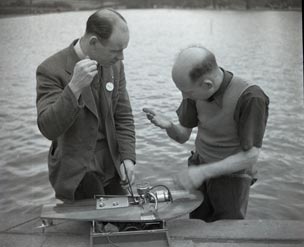 |
| Tom Dalziel with the first of the Naiad hydros | |
Naiad 2 followed in 1949/50 with the same engine mounted in a very deep hull, rectangular in plan and an inverted wing section in profile. 2 sheet metal planes took the place of the sponsons and such was the depth of the hull that the complete exhaust system was under the deck.
With this boat Tom won ‘B’ class awards in the 51 and 52 Model Engineer Speedboat Competition at 46.5 and 48.9 mph respectively. George Lines’ ‘Sparky II’ was some 10 + mph faster and had a stranglehold on the class at that time. In reality, although superbly constructed, the hull and engine design were outdated so Tom set to and built an entirely new and quite extraordinary engine and hull that was to be Naiad 3.
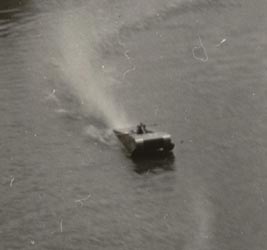 |
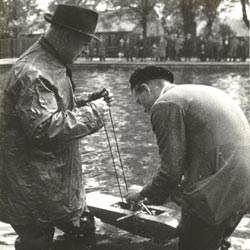 |
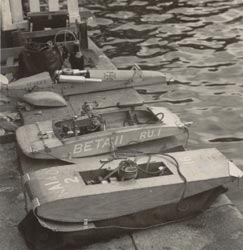 |
| Naiad II | Tom with Colin Stanworth | Contrasting hull designs |
The third boat in the series appeared in the 1956 season and proved to be significantly quicker. In the ME competition for that year a speed of 58 mph was recorded which was a major achievement as Tom Dalziel had avoided the route taken by many fellow competitors of building a ‘Sparky’ clone motor. The hull of Naiad 3 followed a design trend of the time being elliptical in section and a sleek, streamlined, airfoil in plan and profile. The sponsons are attached solidly and faired into the hull rather than on bars. The 15cc motor is a work of art with no surplus metal anywhere. At first glance it may look like a Lines motor but the similarities end with the twin silencers.
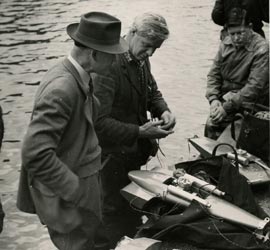 |
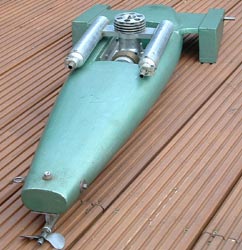 |
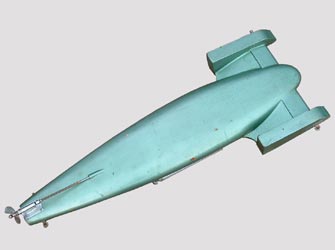 |
| Tom, Naiad III & Jim Bamford | Elliptical, streamlined hull | |
|
|
The porting
arrangement is the most fascinating as it uses the 360 degree
principle but in a quite unique way. Instead of the transfers
being milled into the inner surface of the liner there are 6
conventional passages that match up with windows in the piston
skirt but rather than the transfer ports opening into the
cylinder directly as on all other engines, it becomes even more
interesting. The piston crown is extended to form a combustion chamber but then 6 ports are cut into the side of this space to match up with the transfer ports. A very clever design seemingly intended to scavenge the exhaust gases by opening the transfers very much earlier than conventional porting would allow. |
|
|
|
|
Naiad 3 proved to be both successful and long lived being run regularly into the 1970s. At some stage new, longer and deeper, sponsons were added, although the stark rectangular shape of these detract from what would otherwise be one of the most attractive boats of the period.
|
A wonderful film exists of Naiad III running at Victoria and pecking in on the far side of the lake. From out of the ball of spray came the entire engine unit that was retrieved from further down the lake. The shot concludes with Tom wading back to the bank with the boat in one hand and the engine in the other, and with a smile on his face. When Tom Dalziel finished competing he passed the boat to a fellow club member, who in turn passed the boat to Dave Scarnell, and that is where it currently resides. In 1997 the boat made a ‘guest appearance’ at the St Albans International Regatta. |
|
|
|
Update Nov 2007. Almost as soon as this article was published, Stuart Robinson recalled seeing Tom running a twin hulled boat, but a search of all the records failed to produce a reference to this 'mystery' craft. In an amazing coincidence, just four days later, a collection of photos came to light, and in one of them, Tom Dalziel was holding the very boat in question. A close look at the print shows that the15cc motor featured above had been fitted to this 'catamaran' style hull, probably in the early 70s. The fate of this experimental hull is not known, but the engine was obviously put back into Naiad 3. George Stone achieved a great deal of success with this style of boat and several were built for various classes, but none matched the speed of George's |
| Update March 2011 Having stripped down Naiad for the photos, Dave Scarnell made the decision to put the boat back into running order and rebridle it. It was first taken to Kingsbury, where Arthur Wall and Ron Hankins, seen here on the right, were co-opted into getting it running. The engine proved reluctant to pick up fuel, and after some more attention was taken to St Albans. Here Dave was back in waders, but again the engine would run out a prime, but no more. Frustrated by this, Dave dug his A3 boat out, and came out of retirement. Naiad was returned to the shed, but has now been passed on, in the hope that the fuel problems can be ironed out so that it can be made to run reliably again. |
|
|
|
|
Along with Naiad was another of Tom Dalziel's 15cc 'B' Class boats, seen to the left. The engine shows his normal superb level of craftsmanship and is yet another design variation with the single rear exhaust port. Unusually, the boat is rigged to run in either direction, which must make the fuel feed interesting. A look inside this motor could prove equally interesting. |
When collecting a series of hydro engines that had been bought off eBay, the vendor also passed on the two surviving boats of Tom's and a quantity of spare parts, including props. Both boats were ripe for restoration having been repainted relatively recently in Hammerite that was still tacky in places and had attracted every bit of dirt and oil going. As the collected layers of paint were already lifting in some areas a little careful investigation was revealing. Naiad had started life varnished, which as it was built of mahogany and lime planking would have looked quite stunning. The other had been Hammerite, green enamel, yellow enamel, all over the original blue. Amazingly the layers of paint were over 1.8mm thick in some places.
The engine bay of the green boat had been glassed at some stage, which had not adhered to the wood of the hull so came out in one piece. Having stripped all the offending muck off Naiad 3 was varnished and the other repainted in the original blue. The poor running was easily solved. For some reason, both boats were fitted to run in either direction with bridle attachments on either side, The fuel tanks also had outlets either side so one would be in fresh air as soon as the boat was launched.
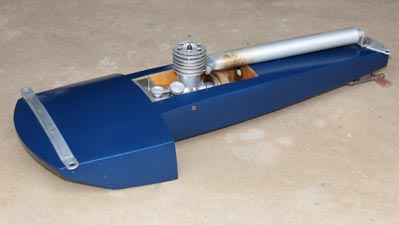 |
|
Thanks to Dave Scarnell for the very detailed pictures, to Arthur Wall for information about Tom Dalziel, Westbury Family and Peter Hill for original photos
©copyrightOTW2007